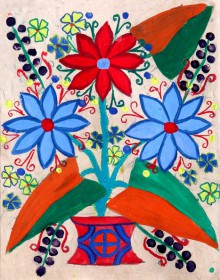Some of these moving pictures have already appeared in prestigious galleries and renowned museums. Over Vasyl Parakhin’s 20-year tenure as instructor at the Zhuravnyky public school’s folk painting studio, he assembled a significant collection of works by his pupils. They have been repeatedly exhibited in Lutsk and traveled to the Ukrainian House and the Ivan Honchar Museum in Kyiv. Their features include amazing ornaments and flowers, depictions of modest peasant farmsteads, Cossacks and churches, swans and firebirds... When looking at the Zhuravnyky kids’ works, I was immediately reminded of my own childhood: I saw these same Cossacks and Ukrainian girls standing near fences and hollyhock clumps in old paintings created by my ancestors which miraculously survived wars and revolutions. “Most likely, precisely this constitutes the much-discussed Ukrainian identity,” a Volyn artist said about the Zhuravnyky kids’ works during the exhibition’s opening ceremony.
For the ongoing exhibition of Parakhin’s folk art school, residents of Volyn should thank Ihor Palytsia’s Charitable Foundation “Only Together.” Due to the charity’s efforts, the event is being held at a new art gallery’s home on the second floor of Lutsk’s central department store, and, according to the foundation’s deputy chair of the board Iryna Konstankevych, people begged to see these paintings even before the exhibition was fully assembled. Director of Lutsk’s House of Education Yurii Voinarovsky, himself a native of Zhuravnyky, told us that the Polish town of Kazimierz Dolny, which he repeatedly visited for folk festivals, had over 40 art galleries. Despite having less than 4,000 residents, the town is one of the cultural capitals of Poland thanks to its role as a venue for folk fests and the home of a renowned film festival as well as its numerous art galleries, and all this combines to attract thousands of tourists. Thus, presentation of this art gallery in a well-attended location of Lutsk’s downtown should also revive cultural life. After all, not everyone would go to the museum on purpose.
Parakhin, introduced by Konstankevych, regretfully described the modern school, which, like its Soviet predecessor, works with the mind of the child while neglecting their soul. In his opinion, no nation-building project will succeed without developing people’s souls. During the classes in his school of folk art, he repeatedly saw how great ethnic environment’s role was, an how important ethnic identity was, because his students included not only ethnic Ukrainian kids, but also Armenians. At the behest of Lutsk Art Museum’s employees, who have long been cooperating with Parakhin and prepared album A Ray of Resurrection telling the story of the distinctive artist and his students, the Only Together Charitable Foundation has been funding Parakhin’s workshops for teachers of Lutsk and other places in the region, as well as for students of Lesia Ukrainka Eastern European National University and Lutsk National Technical University who intend to work as designers and teachers of artistic subjects. After all, the most important thing is to ensure that Parakhin’s talent and his achievements are continued and augmented.









